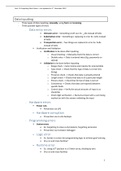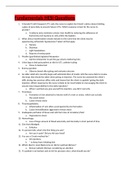Chapter VII: Audio: Music and Talk Across Media
History of Sound Recording and Transmission
● “Nobody’s making any money in digital music … from songwriters and performers, to music services that
had hoped to ease the transition from physical to digital music.” - Paul Resnikoff, editor of the Digital
Music News website
● “The future of the music business isn’t about selling records it’s selling music in every form imaginable,”
- music executive
● “Today may be the best time to be a music fan, with the technology that makes any and all music
instantly accessible. For artists, it may be tough to stand out today.” - Flea
● Timeline of the Development of Recording
○ 1877: Edison’s phonograph was developed and the first recording was “Mary Had a Little Lamb”
which focused on a dictation machine
○ 1888: Emile Berliner invented the first flat record on the gramophone which was seen as an
entertainment device
○ 1935: hi-fi made recordings with better sound and pitch
○ 1949: magnetic tape recorders were commonplace in studios
● Time of the Birth of Radio
○ 1844: Samuel Morse invents telegraph, transportation is no longer a limit to communication but
the wire itself caused issues
○ 1888: Heinrich Hertz began developing antenna signal
○ 1894: Guglielmo Marconi creates wireless telegraph, a point-to-point radio transmission
● Radio as Mass Communication
○ In 1901, Reginald Fessenden begins broadcasting poetry and Christmas carols via radio
transmission
○ In 1915, visionary David Sarnoff writes “The Radio Music Box” memo in which he outlines what
radio can (and will) be as a social institution
● Radio Ads
○ WEAF of New York was the first radio station to sell airtime for advertisements
■ The success of their commercials led to national oil companies, American Express, and
department stores ads in ratios
● One of the most notable ads would be the Alka Seltzer ‘Plop Plop Fizz Fizz’ ad
in 1958
● The Golden Age of Radio
○ The age was considered to be around the 1920s to the 1940s before television was invented
○ People were getting most of their entertainment from outside their home for the first time with
radio
■ Dramas and actions: Little Orphan Annie, The Lone Ranger and The Shadow
■ Soap operas - short daytime dramas targeted toward women, Guiding Light got its start
on the radio in 1937
○ Amos ‘n’ Andy was the most popular radio show that began in 1926
■ The radio show was played in restaurants and theaters so people would still leave their
house during its broadcast
● The show went to later on broadcast a television version later on
● The BBC
○ It started back in the 1920s as a public service
, It was the international voice of opposition to the Nazis during WWII and now has an
■
audience of 150 million
● There is now a large international reach due to its successful television series over the years
○ It was also a source that was not censored by local governments in most countries so
was a popular broadcasting service
● Changing the Musical Experience
○ Recorded music lead to the death of “social music”
■ Social Music: music that people play and sing for one another in the home or social
settings
○ The Walkman allowed people to have a musical cocoon by 1979
Music, Youth Culture, and Society
● Rock ‘n Roll
○ There was a cross cultural phenomenon spurred by WWII as races interacted more often due to
allowing people of color into the military and interacting with them much more at the time of
war
■ Before 1948, all music recordings by black musicians was called “race records”
● The first rock ‘n roll song can trace back to Wynonie Harris’s “Good Rockin’
Tonight”
○ rnb and folk genres started to emerge on the Billboard charts by 1949
○ By 1954, Elvis would cover “Good Rockin’ Night” which starts a chain reaction of a series of
songs produced by musicians that used the word “rock” to describe the genre they’re performing
■ Rock music wasn’t played on white radio stations because the term “rock” was a sexual
reference and considered filthy
● Elvis Presley
○ He was first recorded a soundtrack in 1953 at the Memphis Recording Service
■ Many listeners of have said he was “a white man with black sound”
○ During a 2005 Rock and Roll Hall of Fame and Museum interview with blues, rnb, and soul
guitarist and vocalist Little Milton Campbell discusses how Elvis Presley broke down racial
barriers and integrated races to bring rock and roll to the masses
● Chuck Berry
○ He borrowed the Hillbilly sound in his music
○ Broke out the restrictions of traditional blues and also had an unconventional style that made
people take notice of him and his music
● Rock Radio
○ Dewey Phillips and Alan Freed played what the kids wanted to hear regardless of race
■ Phillips’ Red, Hot, and Blue show was an instant hit on the radio
● Motown
○ It was founded by Berry Gordy
■ Black artists turned out to create major hits as black music moved into mainstream
○ Motown music mirrored changes in society
● Girl groups
○ They were popular during the late 1950s and the early 1960s
○ Consisted of women harmonizing together
, ■ Groups like The Shirelles, The Ronettes, The Supremes, and The Shangri-Las swept the
nation
● The British Invasion
○ 1964 was the era that brought the rougher version of rock
■ Bands included in the British Invasion were The Beatles,. The Rolling Stones, Cream,
Led Zeppelin, and The Who
● They often borrowed from and performed with famous blues musicians like
Muddy Waters
○ The Beatles started the idea of a concept album - an album with a theme with Sgt. Peppers and
Lonely Hearts Club which meant that the album was meant to be played from start to finish and
the band was still the best selling band today even beyond disbandment
■ Made to be recorded and the importance of producers emerged
● Disco
○ The 1970s was the time that there was music that got people to dance
■ It was the first genre that depended on technology and producer-paved the way for hip
hop and techno music years later
● Hip-hop
○ Hip-hop was a cultural movement of the 70s and 80s
■ There were four elements: MC-ing, DJ-ing, B-boying, and graffiti art
● It evolved from and combined a variety of influences from around the U.S.
● Country
○ Country originated from the 19th century from a blend of Scottish folk music, Mississippi blues,
and Christian gospel music, being originally called hillbilly or old-timey
○ Jim Reeves, Patsy Cline, and Eddy Arnold were the ones that took over the 50s
■ The genre was revived during the 90s and 2000s with Rascal Flatts, Johnny Cash, and
Carrie Underwood
● The “perfect” country song was considered to be “You Never Even Call Me By
My Name” by Steve Goodman
From Singles to Digital Downloads: Making Money in the Recording Industry
● MP3s and a New Industry
○ MP3s and CS were easily burned, shared, and portable way to carry music
○ New groups can publicize their music and deliver it to listeners without record labels
■ Publishers have tried various methods to stop pirating but there’s always a hack as
pirating music was very easy at the time due to being a new thing with computers
The Future of Sound
● Streaming and Podcasts
○ Streaming served a growing importance of mobile devices as phones became accessible to
everyone
○ Pandora now provides more than 5% of all hours Americans spend listening to radio and with
podcasts, anyone can be a DJ
● Satellite










